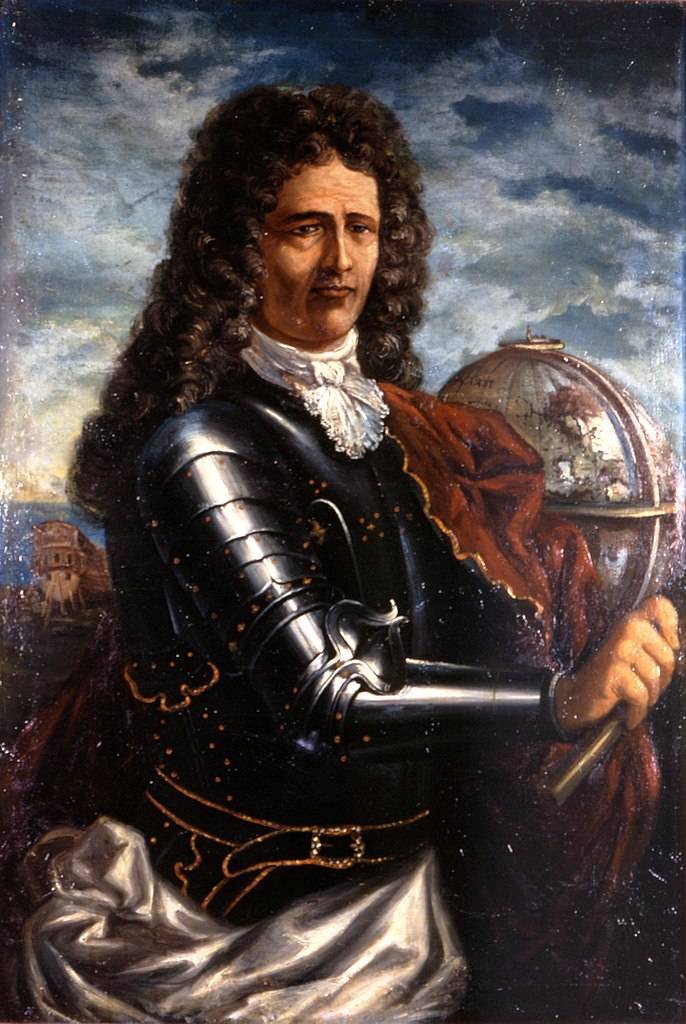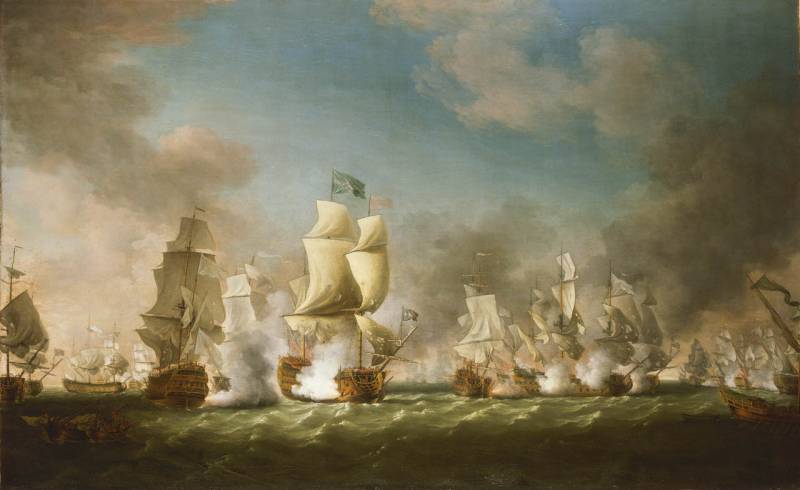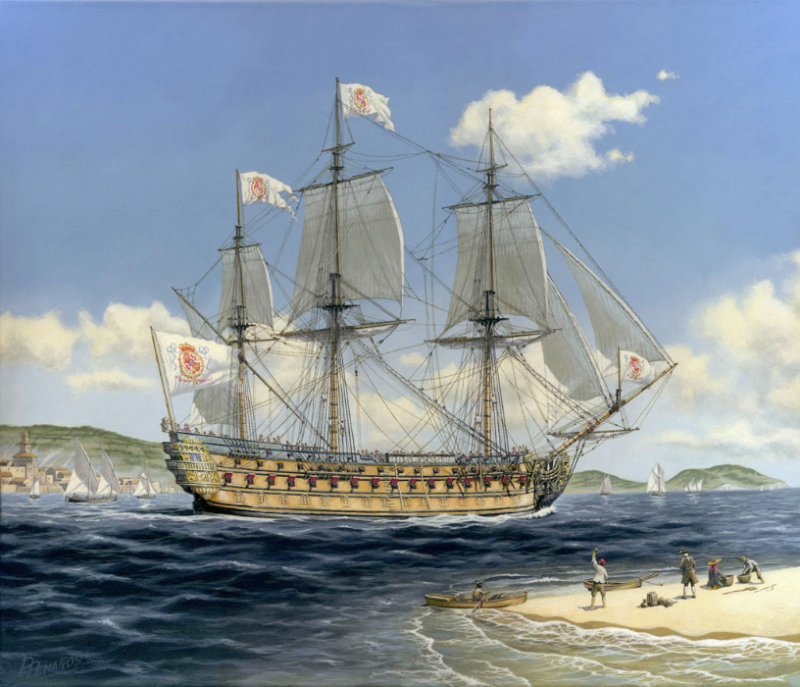Armada officers. Jose Antonio de Gastagneta

In the service of the Habsburgs
Jose de Gastagnet was born in 1656, in the city of Motrico, in the Basque Country, in a family associated with the sea for many generations. His father, Francisco de Gastagneta, owned his own ship as part of the Indian fleetwhose ships carried goods between the colonies and the mother country. Already at the age of 12, Jose aboard the galleon set off on his first voyage in India (i.e. America), with which his systematic training in marine affairs began. Combining theory and practice, Gastagneta studied the exact sciences like mathematics and astronomy, mastered the basics of navigational science, began to get acquainted with the technology of building ships. At age 16, on the Aviso ship, he and his father sailed to Veracruz, Mexico, where the venerable Francisco died, and young Jose had to return home already commanding his own ship. Despite the fact that this was his first voyage as a ship captain, and the route was not the easiest, Jose first proved himself to be a skillful and promising sailor - Aviso returned home on time without any adventures, and the ship’s crew respected the young lord Gastagnet, who, among other things, proved to be an excellent navigator. Thus began the story of one of the most important characters in the history of the XNUMXth century Armada, who will have time to leave his mark on its development for many years to come.
At the age of 28, he was already a seasoned sailor who made 11 independent voyages to America, including very close and difficult ones - to Argentina, to Tierra del Fuego and beyond Cape Horn. All of them were successful, brought him profit and reputation, and Gastagnet could continue to continue in the same spirit - but the soul of a sailor demanded more. In 1684, he enters the ranks of the Armada, undergoes training, and two years later receives the title of capitan de mar - i.e., captain of the sea. It should be noted that such an act at the end of the XVII century was quite peculiar, since service in Armada did not promise him much success and prospects - the Spanish Navy during the reign of King Carlos II was in such a severe crisis that voices were heard that a little more - and he will completely disappear from the seas. Is it a joke - while the leading maritime powers had several dozen or even hundreds of ships of the line that made up the core of the fleets of that time, Spain at the time of the death of the last Spanish Habsburg had only 8 (eight) of these ships, and their condition was so sad that almost all 5 of them were being repaired at the dock, or were in reserve! Even Scandinavian countries like Sweden and Denmark were doing better. And it was at this time that Jose de Gastagneta became the next captain of the Armada. It is difficult to say what he was guided by - a patriotic impulse, hopes that the Spanish fleet would all be reborn, and again would be a storm of the seas, or something else. But the fact remains - abandoning the dusty work of a private merchant, he entered the public service in Armada in very difficult times for her.
For Gastagneta, there was no ship for command in Armada, because in 1687 he was assigned to Cantabria, to the royal shipyard in Colindres, where he supervised the construction of various ships. Here, for the first time, Don Jose’s talent for shipbuilding was clearly manifested, because he not only knew the theory, but also knew how to use it in practice, and most importantly, having an inquiring analytical mind, he immediately began to look for ways to improve the construction of ships, and wrote his first work on this topic is “Arte de fabricar Reales” (I will leave the names of the works without translation), which addressed the organization of works for the construction of warships. In 1691, he was transferred to Cadiz, where he also began to command individual ships or small formations in the Mediterranean, interacting with the Anglo-Dutch allies in the war against France. Here he showed himself well enough to receive at first promotion to the admiral, and then to the real admiral (Almirante Real, Royal Admiral, rank at the end of the 17th century in Armada). In 1694-1695, he rather actively operated on the sea, where he again showed his first talent as a navigator, skillfully guiding a convoy of ships under the noses of the French from Naples to Mahon, and also luring the detachment of Count de Tourville under serf cannons. Also at this time, he writes and publishes another book in 1692 - “Norte de la Navegación hallado por el Cuadrante de Reducción”. This work was entirely devoted to the navigational business, and for the first time introduced the use of an improved instrument, the quadrant, which will later be modernized and introduced after the 1721 year around the world as a sextant, and the discoverers will be granted the right to the British by John Hadley and Thomas Godfrey. By 1697, almost the entire Armada had already switched to using the Gastagneta quadrant, which simplified navigation, and Gastaneta was considered an outstanding sailor and was respected not only at home, but also abroad. He did not have a chance to rest on his laurels - in 1700-1701 he went to New Granada and was responsible for the ousting of the Scottish colonists who tried to settle on the shores of the Gulf of Darien, thereby threatening Spain's sovereignty over the region. He didn’t have to do this for long - at the beginning of 1701, disturbing news came from the mother country: King Carlos II died childless, and now there is a war between two applicants, Felipe de Bourbon and Carlos Habsburg. Jose Antonio de Gastagneta immediately returned home and swore allegiance to the Frenchman. From this moment began the most active and significant period of his life.
Admiral Bourbonov
Since the Spanish shipbuilding industry was in deep decline along with the Armada, and ships and sailors were needed for the war, Gastagnet, as one of the most respected commanders of the Armada with experience in the necessary areas, was appointed responsible for the revival of this industry. In 1702, he became superintendent of the factories and plantations of Cantabria, having founded the Guarniso shipyards near Santander, near which the village of El Astillero grew up. From that moment, José Antonio de Gastagneta begins to systematically build what Spain will rightfully be proud of in the future - a well-organized centralized shipbuilding, with the widespread use of standardized elements. In addition to the Guarniso shipyards, he also founded a number of enterprises on the rivers Sorros, Orio and Pasejas, in the Basque Country. Don Gastagneta was also responsible for the defense of the shores of the Bay of Biscay, and became Mayor of Motrico, concentrating in his hands power in many areas of life throughout the northern region of Spain. In 1712, he published a major treatise “Proporción de las medidas arregladas a la construcción de un bajel de guerra de setenta codos de quilla”, which described all the nuances and preparatory work necessary to organize effective shipbuilding. It addressed such important issues as the correct harvesting, drying and processing of wood. This treatise immediately began to be distributed throughout Spain, although there were problems with the introduction of all the processes described in it.
Events in Europe soon forced Don José Antonio Gastagneta to return to the current fleet and lead it. Philip V, having finally established himself in Spain at the end of the war for the Spanish inheritance, began to pursue an active foreign policy, which implied, among other things, a war with opponents. One of his global plans was the creation of satellite states around Spain, which would be controlled by children from his marriage to Isabella Farnese, a very vibrant and politically active woman, who came from Parma. In preparation for the war, Gastanyete had to go to Holland in 1717 to agree on the purchase of ships there, and then led the invasion fleet in Sicily. The landing was successful, a flotilla of 23 warships (battleships and frigates) was parked at Passaro when the British fleet (22 ships) arrived under Admiral George Bing. Despite political tensions, a war between Spain and Great Britain was not declared, because there was no particular reaction to the appearance of strangers, and in vain - in spite of the peace between the two states, Bing attacked the Spaniards and launched a massacre. Two ships were sunk, 11 - captured by the British and taken away as prizes, four ships and frigates managed to escape. The main forces of the Armada were defeated, Admiral Gastagnet was captured. Only four months later did the war of the Fourth Alliance begin, which two years later ended in the defeat of Spain. Gastagnet himself was saved from major problems due to the battle by Passaro because he and his ship fought bravely, the admiral was seriously wounded in the leg, and the British committed their attack treacherously, without declaring war - which, however, could be predicted, knowing the character of the English themselves.
Soon, the 62-year-old don Jose Antonio returned from captivity, but due to injury and age, he left the active fleet for some time, returning to shipbuilding issues. In 1720, his new large-scale treatise “Proporciones de las medidas más esenciales para la fábrica de navíos y fragatas” was published, which concerned directly the theory of the ship - which contours are better suited for certain purposes, what length-to-width ratio should be for linear ships and frigates, how to build them better, etc. Together with other works, a system was formed that in 1721 was recognized as binding by a special royal decree, and shortly after that, individual elements of the created system began to be used not only in Spain itself, but also abroad. After this, Gastagneta returned to the current fleet, becoming one of the admirals of the Indium Fleet, which was responsible for the transportation of colonial wealth to the metropolis. During the next war with Great Britain, in 1726-1727, he, using his navigational skills, masterfully conducted a convoy with gold and silver under the nose of the English fleet for a total cost of 31 million pesos, and at some point he had to literally break through the patrols the English in the middle of the night, but they could not even find the Spaniards who freely reached the coast of Galicia. Upon learning of this, the king was delighted, and granted the admiral himself the life pension of 1000 ducats per year, and 1500 ducats a year to his son José Antonio. but news Gastagneta didn’t get about this anymore - being at a very respectable age (71 year), he died in Madrid on 5 on February 1728 year, shortly after his return from India.
Heritage
As admiral, Don José Antonio de Gastagneta proved to be quite peculiar. He lost the only major naval battle with the enemy (at Passaro), but it was hardly his fault here, because the British attacked without declaring war, and, strictly speaking, with a numerical equality of forces, they had more guns and better trained crews. The latter was generally extremely remarkable - in the era when the artillery battle decided everything, the Spaniards “lagged behind”, still boarding, and the consequences of the country's decline during the last Habsburg led to the fact that there weren’t so many good sailors, so even if Gastagneta was ready for battle, his outcome would still be sad. But at the same time, it cannot be said that as a naval commander he was bad - on the contrary, having proved himself to be a great navigator and master of maneuvering actions, he was also clearly an excellent organizer, so what knowledge in navigation could not save his squadrons if ships failed to sail. Meanwhile, the actions in the Mediterranean Sea and on the way from India say the opposite - the fleets under the leadership of Gastanyeta acted quite decisively as a whole, clearly fulfilling the orders of their admiral, which can also be put in his merits.
But no achievements in the field of command of the fleets can not block the contribution that Gastagnet made to the development of shipbuilding in Spain. Having found him almost in ruins, this inventive biscuit laid the foundation for his magnificent revival that took place in the 2 half of the XVIII century. The Guarniso shipyards founded by him during all the time of their operation put into operation 37 ships, not counting small ships, and it was on them that the “Real Felipe” was built - the first three-deck ship in the history of the state, which was designed according to the precepts of Gastaniet himself. These testaments themselves were drawn up into one specific system, which clearly defined how to store materials for building ships, how to store and process them, what characteristics ships should have, what ratio of length to width, etc. - in short, it was a whole set of laws for shipbuilding, the “Ship’s Bible”, which, when followed, could build beautiful ships, which the Spaniards later did. He laid in the design of the Spanish ships what later became the "highlight" of Armada - excellent side protection of the ships, up to four layers of oak or mahogany, up to a meter thick, and even more, as a result of which it sometimes failed to break through the sides of the Spanish ships even at fire right up to the heaviest guns. In addition, a well-developed and standardized shipbuilding system made it possible to build ships not only cheaper and better, but also faster - in particular, thanks to the “Gastanyeta system” in Ferrol they could build frigates within a few months after the issuance of the order, mass and mass production, and, most importantly - cheap. True, this was achieved after the death of Gastagneta himself - too much time was required to set up the entire infrastructure, develop the nuances of the mechanism, develop practical skills, and train personnel. The same “Real Felipe”, being an excellent ship under the project, and quite well built, due to lack of wood, which was poorly prepared and stored, already a couple of years after the commissioning began to flow and dry up - which, however, did not prevent it to serve quite solid for their time 18 years. In fact, all subsequent shipbuilding in Spain was built on the works of Gastagneta, and his achievements were used and appreciated abroad.
In Motrico, his hometown, Gastagneta built a manor in which his descendants then lived. One of them was a modest and very smart boy, who, inspired by stories about his ancestor, also went to serve in Armada and achieved impressive achievements during his service, largely repeating the way of Gastagneta as an organizer and analyst. But he was not heard by the authorities and died at the Battle of Trafalgar. The name of this boy is Cosme Damian Churruka and Elors, and his figure left such a big mark in the history of Armada that he needs to devote a separate article. And that means the story is not over yet.
To be continued ...


Information